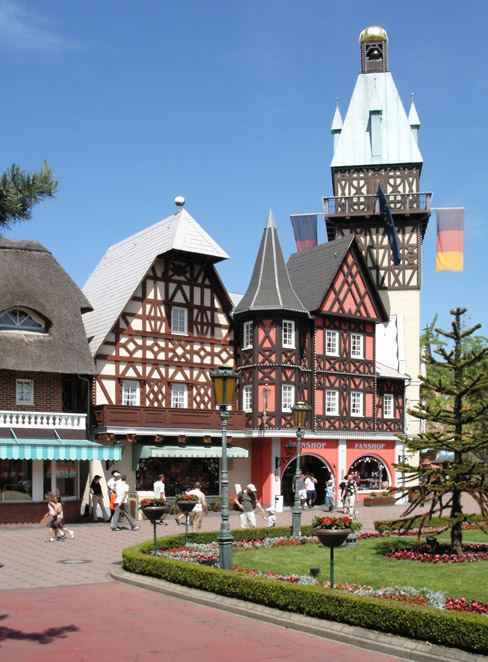
Those lamenting the fact that the introduction of the Bologna Reform has sounded the death knell of the good old German diploma certificate can rest assured. It is manifestly still going strong. Take the Half-Timbered Guide Certificate, for example, which was introduced in 2010. Germany’s veteran comedian institution Loriot would have gone to town on the oh-so-typical moniker of Half-Timbered Guide Certificate. Precisely because the matter is hardly wooden.
Certified half-timbered guides no doubt know all the ins and outs of German half-timbered architecture, such as are abundantly on display along the German Half-Timbered Houses Route. They are trained by the august “Arbeitsgemeinschaft Deutsche Fachwerkstädte e.V.”. The folks they guide do not even need to be tourists; locals equally like to discover the secrets behind the artisanal art of carpentry as it was practiced before the introduction of CNC milling machines. They are introduced to an art that has become alien to them because today there is no reason to practice it. Well, not quite, but we’ll return to that below.
Qualifying as a half-timbered guide is a serious business. Because there is big money involved in half-timbered architecture. For one, it drives tourism, which is certainly to the great (financial) benefit of those towns blessed with an array of half-timbered houses. Plus those holding a Half-Timbered Guide Certificate can make big money taking people around their towns’ half-timbered hotspots. Germans are deeply in love with anything half-timbered these days. By contrast, in the past the relationship was characterized by a mix of necessity and pragmatism: Timber was abundantly available, and such edifices were strong and sturdy. Only later did timber frames at times come to be considered ornamental, or rather in the majority of cases they simply got smothered by a layer of rendering or slate to prevent the wood from being damaged. Meaning that these buildings were not all dolled up as if for a masked ball such as to disguise their true identity, but simply clad. Purely for the purpose of protecting them, just as we clad ourselves in an outer layer to protect our bodies from the adverse elements. Sure, there were examples of fancy façades too, destined to make the house look more precious than it actually was.
People have not always associated timber framing with decorative ornamental qualities; indeed, on occasion a half-timbered façade pointed to the fact that the building’ owners were unable to afford a house made of stone. Those were the days when Gottfried Semper was able to develop his cladding theory, which distinguished between symbolic and technical aspects of construction or, if we take our cue from Kenneth Frampton, between representative and ontological aspects. Interestingly, the half-timbered structure represents a condition that does not require such a distinction to be made. In more general terms this means: The representative is identical to what it represents. Everything appears at face value, and is in perfect intrinsic harmony. Or along these lines. One could surmise that this is how modern man might imagine Paradise to be. Probably because he cannot quite remember what he is or what he’s supposed to be. In other words, having as many half-timbered houses as possible is the best thing that can happen to a German town today. Or should one say, being able to proudly display as many half-timbered houses as possible.
Those municipalities a little short on timber structures simply create their own, either by relying on professional restorers or, if there is no other option, be reconstructing the past. Not so long ago, in 1979, the common consensus was that passing through the historical town of Wetzlar you could see “the odd” example of a half-timbered house. Today you really have to go out of your way to avoid them. Incidentally, the reconstruction of a half-timbered house does not present a major challenge, as the chances are that any historical settlement will have had a half-timbered house standing on it somewhere. If you are struggling to endorse this half-baked reconstruction craze yet reluctant to believe the killjoys – such as socio-geographer Andreas Pott or art historian Gerhard Vinken (the latter claims that the historical town is “something specifically created for the tourists’ mindset” and the former suggests it was “invented by modern urban designers”) – then you’ll probably need to fall back on a different device, identity. In the sense that half-timbered houses form part of a town’s identity. Or indeed a city’s or a region’s identity. Careful with the word ‘nation’ these days, of course, but if you have readily opted to go down that road that calls itself “German Half-Timbered Houses Route”, a national identity is probably only just round the corner.
So, the notion of identity. Do architects have the slightest idea what precisely is meant by identity and who is supposed to be, or indeed feel, identical with someone else at a particular point in time and for whatever particular reason? As it turns out, identity seems to be the shy sort. The sort that definitely is in danger of disappearing if it is constantly cited. Which is why timber framing comes in handy here. And who knows, it may indeed be helpful for those other locations, those outside of the glitzy downtown areas glammed up for tourists and inhabitants lacking in identity, which bear the brunt of all the architectural garbage not earmarked to strive for an identity or to represent anything, other than economic interests perhaps. The downside is that no superbly qualified half-timbered guide will give a flying fiddle about these structures. Incidentally, it takes just six days to qualify as a half-timbered guide. Now ain’t that quaint.




